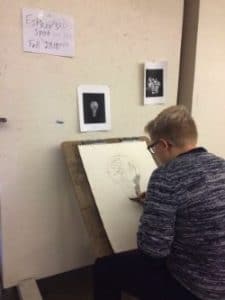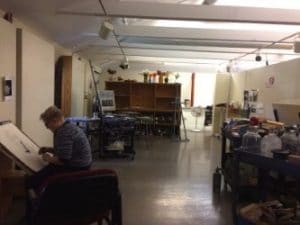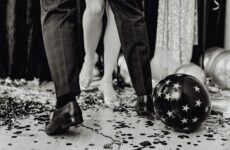By Kitty Williams | Associate Editor
Sara Bareilles’ singing echoes from a speaker in the corner of the drawing studio. The room is on the second floor of Antone Academic Center, undiscovered by the casual Antone-class-attending student. A wall that divides the room but doesn’t quite reach the ceiling serves as a perch for a man built of chicken wire. A few students sit on the other side spending their Saturday afternoon working on their art. The sound of their voices travels to the side of the room where Esther Hoekstra is working.
 Hoekstra is sitting on a bench, leaning into her easel with a pencil in hand. Above the easel is a board occupied by a piece of paper with “Esther’s Spot Fall 2016” written on it, two photographs, and pinholes scattered like stars in the galaxy. The photograph on the left is a black and white image of a light bulb. To the right and slightly above is another black and white image of a light bulb, but this one is shattered.
Hoekstra is sitting on a bench, leaning into her easel with a pencil in hand. Above the easel is a board occupied by a piece of paper with “Esther’s Spot Fall 2016” written on it, two photographs, and pinholes scattered like stars in the galaxy. The photograph on the left is a black and white image of a light bulb. To the right and slightly above is another black and white image of a light bulb, but this one is shattered.
“It could be a metaphor for something,” Hoekstra says, reflecting on something a professor told her. “It could be all your hopes and dreams are crushed, which could be depressing.” Offering a happier alternative, she adds, “But if you take it the other way… it could be that you were first broken and now you’re whole.”
As an art major with a concentration in graphic design and photography, Hoekstra has always seen art as an important form of expression. “It’s a way for me to show people without words how I’m feeling,” she says. As someone who suffers from depression and bipolar disorder, she turns to art to help her through life’s difficult moments.
Art is also a means by which Hoekstra can explore gender and sexuality. Last year, she worked on a photography project that involved taking portraits of different people in an effort to capture how they express their identity. In the portrait series, she included a self-portrait because she identifies as transgender and genderqueer.
Amber Blanchette, a friend of Hoekstra’s, also found herself in front of the camera for the portrait series. “I wore a very girly outfit as usual,” she says. As a fellow artist, Blanchette has a unique perspective into Hoekstra’s work. She understands the creative process that brings a piece of work from that original idea to the final piece. Thinking about the messages within Hoekstra’s art, she says, “I think sometimes she struggles with how she wants to say it, but it usually does reflect her personality.”
Recently, Hoekstra went through a time of doubt in her work. This doubt can spark thoughts that she should maybe do something else. “It’d be cool if I could be a park ranger or something,” Hoekstra says with a laugh. She has always had an interest in environmental science. These thoughts are “just fleeting,” she adds, though these interests sometimes creep their way into her work by way of landscape photographs.
In these times of doubt, Hoekstra will seek guidance from her former Drawing I professor, Dr. Gerry Perrino. “He shows you how to be one with yourself and with your artwork,” says Hoekstra. Perrino has a similar admiration for Hoekstra. “On top of having the potential to become an outstanding artist, she’s already an outstanding human being,” Perrino says.
“She doesn’t think that she is, but she’s a very brave person,” Perrino says in regards to her struggles with gender identity. “She deals with it gracefully, and beautifully, and openly.” He thinks this is reflected in her art in an inspiring way. “She’s not sure exactly what it is that she’s trying to say, but ‘whoever I am, I should be allowed to be that.’”
She didn’t have the same guidance back in high school that she has now. Her art education began in her Connecticut private school art class of only two students. Looking back on it, she wishes her art career had started differently. Every artist has a particular piece of work he or she has been less than satisfied with. For Hoekstra, that includes “basically all the work I did in high school.”
Hoekstra’s passion for art came from her mother. She remembers at a young age having her mother’s paintings on display in the house. “She used to draw naked women,” laughs Hoekstra. “That’s all I remember because it was embarrassing when kids used to come to our house and there’d be a naked woman on a painting.”
As a perfectionist, Hoekstra hopes her work will improve as time goes on. She meets a question of future goals with uncertainty. She sees herself “maybe working for myself independently  or something, selling artwork.” She also considers “working in a graphic design company maybe in Europe or something.” She’s still not sure exactly what she wants to do, but she knows the opportunities are endless.
or something, selling artwork.” She also considers “working in a graphic design company maybe in Europe or something.” She’s still not sure exactly what she wants to do, but she knows the opportunities are endless.
For now, she will continue her work: shading things in, erasing mistakes, continuing to bring emotion and meaning to the outline of an intact light bulb that stares back at her from the page. The music coming from the corner of the room moves from Sara Bareilles’ “I Choose You” to “Gravity”: “Here I am, and I stand so tall, just the way I’m supposed to be.”














